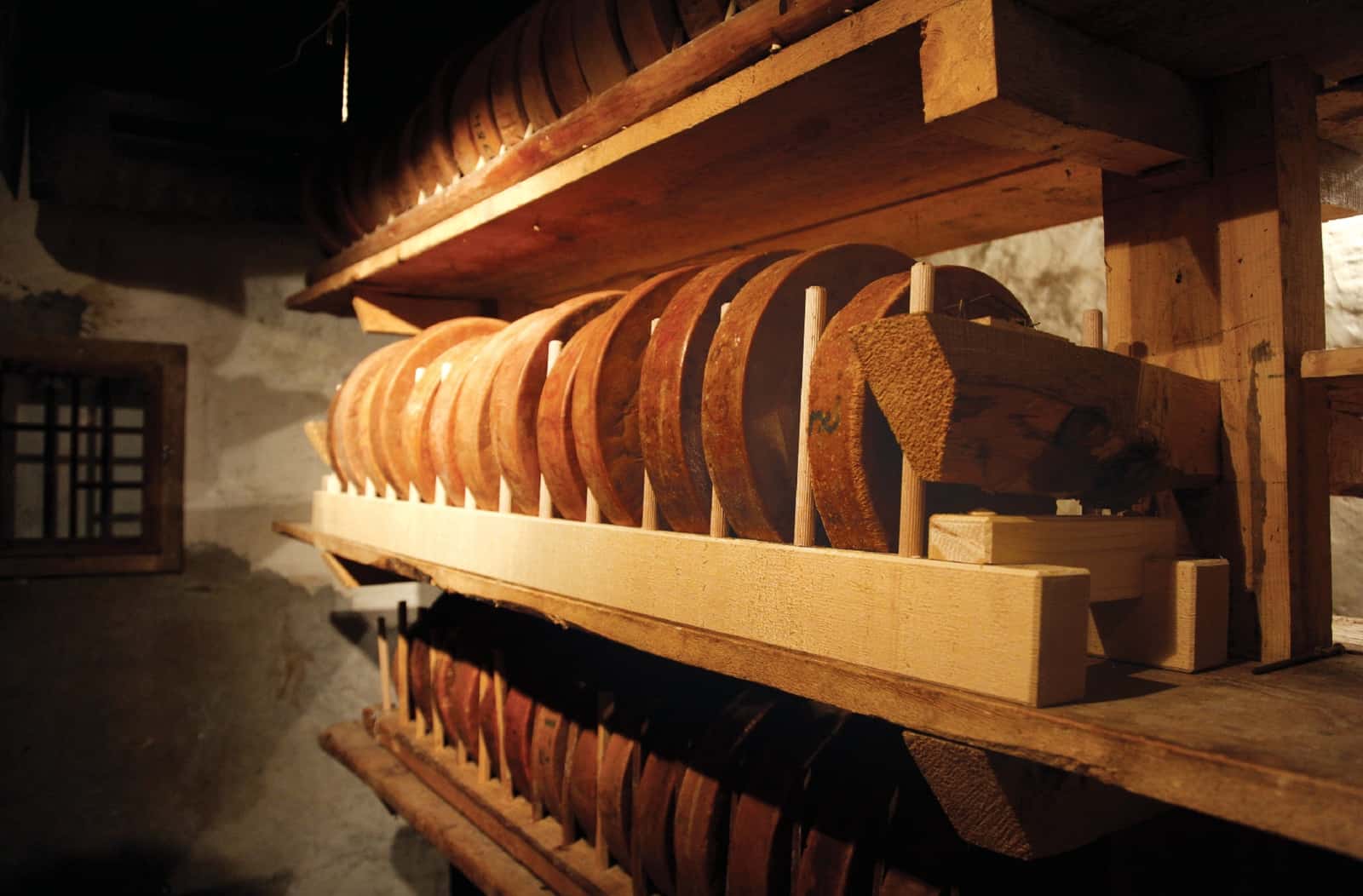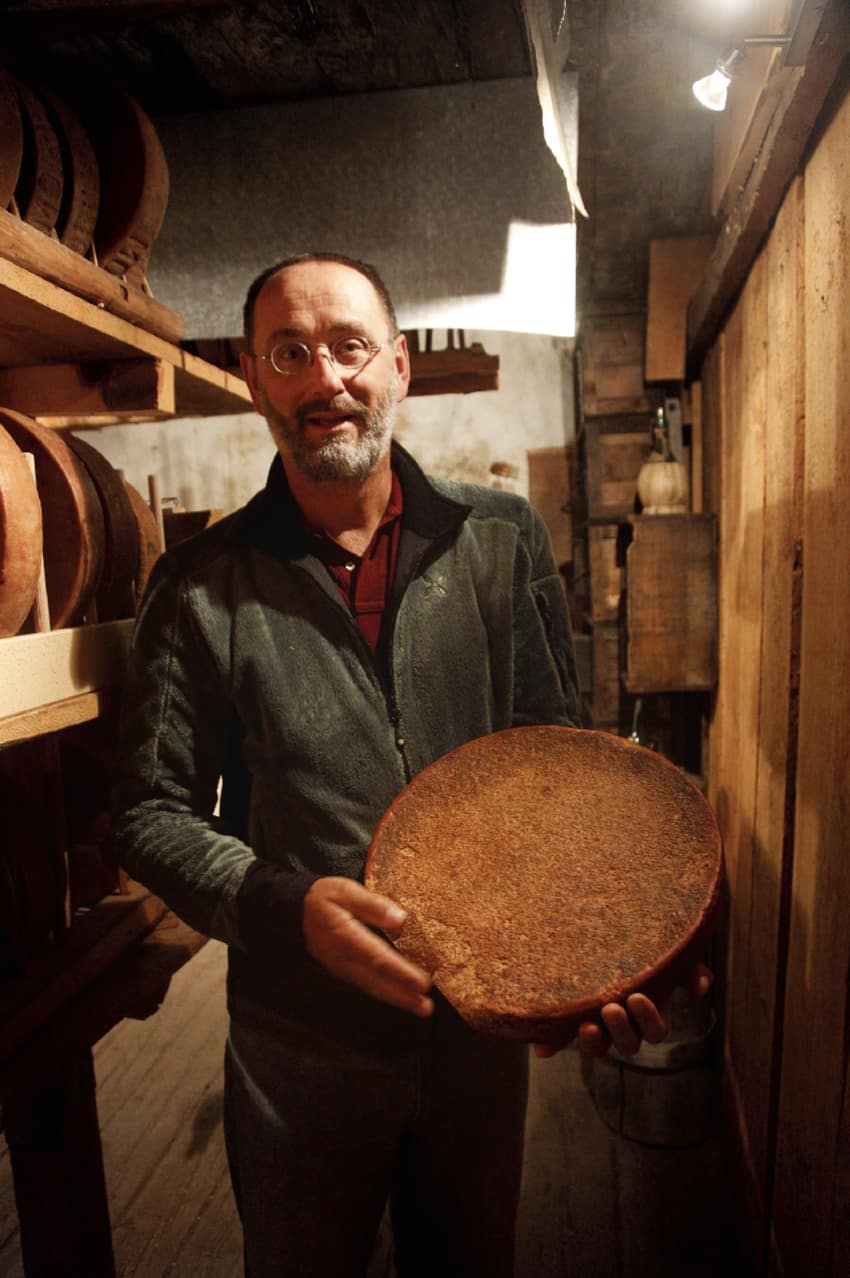
On a misty morning last summer, I embarked on a mission to find the oldest cheese in the world. Dawn was barely breaking as the car wound up the road toward Grimentz, a small Swiss village that seems to cling to the cliffs of the Anniviers valley. When I arrived, the town square was shrouded in a cloud. I could barely make out the tall frame of a man with tiny glasses standing in the thick fog.
I knew of Jean-Jacques Zufferey only by reputation—curious rumors had been spreading about a guy way up in the mountains with centuries-old cheeses in his basement. With a few calls to village officials, I’d successfully tracked him down. He agreed to meet me in the morning before he went to work.
From the town square, we walked toward his house, passing wooden chalets with geraniums spilling off balconies. At first glance, Grimentz seemed impeccably chaste—but as I’d soon learn, these tidy households once harbored a morbid custom. This is the valley of the fromage des morts, or “cheese of the dead,” a tradition in which each person is given a wheel of cheese—made especially for them—to be aged until their death and served at their funeral reception.
The Alpine-style wheels would be gifted early in life—sometimes around baptism, often at marriage—and stored in the basement of the family house. Pending luck and longevity of the recipient, the cheeses would sit there for decades, becoming as hard as wood. By funeral time, they’d require a saw or an axe to slice, and would taste pungent and rancid, necessitating a quick chaser of the local vin des glaciers—another funeral staple.
Zufferey isn’t sure why a couple of cheeses were forgotten in the corner of his grandmother’s cellar for 140 years. Maybe it was the consequence of clutter, or perhaps a result of the waning funeral tradition, he speculated, as we stepped through a tiny door into his family’s cave, a distinctive smell of musk and ammonia enveloping us.
He gingerly lifted a wheel from a wooden shelf. Dark brown and shriveled, with a glossy surface, it reminded me of the bog bodies I’d seen in museums, their skin like solidified leather from millennia spent buried in peat. “You can touch it,” he said, sensing my curiosity but cautioning: “It’s still oily; it will smell on your hands.”

Zufferey cradles a wheel of cheese made in the 1870s.
Zufferey’s father discovered the wheels—stamped with the signature of the man who made cheese locally in the 1870s—after his grandmother’s death in 1944. Fascinated by the find, the family began adding cheeses to the collection every few years; by now, those additions are about 75 years old. Engraved with images of cow fights and mountain vistas, the wheels are relics never meant to be consumed. But, of course, I still wanted to know: Could they be?
Like people, cheeses have lifespans. Affineurs go to great lengths to expand their longevity, controlling humidity and temperature levels in spotless facilities. In a nondescript basement like this one, you’d think that wheels aged out in the open would dry and crack, or else be consumed by mice and mites. But aside from a nibble or crevice here and there, Zufferey’s cheeses are remarkably intact.
To understand what could make these Alpine wheels so sturdy, I turned to Jean-Marie Droz, a Swiss master cheesemaker and export manager at 1655 Gruyère. He explained that Alpine cheeses are fundamentally designed to preserve milk’s nutrients over a long period of time—to be durable. Early in the aging process, moisture evaporates from the wheels, drying the surface. Fat also leaches out, forming a protective barrier that slows evaporation and traps a certain amount of moisture inside. There, communities of microorganisms subsist on water and nutrients, while enzymes they create break down protein chains into flavorful amino acids. The quiet stillness of a cheese cave belies little of all that activity inside the wheels—which can go on for years and years beneath a sturdy rind.

A wheel of raclette, an Alpine-style cheese.
Zufferey was determined to see if something was still happening within his wheels. “I had to see if we could find something living,” he said. If bacterial strains were still active in the cheese, that could reveal something about the cultures used to make the original Raclette du Valais AOP, a similar cheese that hails from this region. The microorganisms could also be cultivated and incorporated into modern-day recipes. “We could continue something from another time,” Zufferey said—“the Jurassic Park of cheese.”
Breaking off a morsel that had already been chewed by a mouse, Zufferey sent a sample to a laboratory in Zurich to see if there was anything stirring. The verdict? No life; this particular fromage des morts is, in fact, mort. But there was still one revelation echoing from the past: The lab discovered that this cheese was made with goat’s milk in addition to cow’s milk—a curiosity in a region where bovines now reign.
At this point, the cheese is more fossil than funeral snack. Droz isn’t surprised; despite the protective effect of the rind, he says, evaporation of the cheese’s moisture is still inevitable. For the microorganisms inside, the gradual loss of water makes survival difficult. “After 10 years, 20 years, if a cheese is in an area cold and dry enough, the aging will be slowed down, and eventually it stops,” Droz says. “At a given point, there’s no more life.”
After saying goodbye to Zufferey, I found a tiny cemetery on my way out of the valley. As I strolled past carved wooden crosses and patches of dirt bursting with flowers, I thought about those cheeses. How long before they finally crack, disintegrate, and settle into the dust? It’s likely inevitable, but maybe there’s no way to predict it—a lesson in mortality for all of us.
Photography by Molly McDonough




What about the 3200 year old cheese found in Egypt? So interesting. Surely someone is courageous enough to try!
So crazy right? Probably not edible anymore, but we’re definitely curious about the tasting notes.